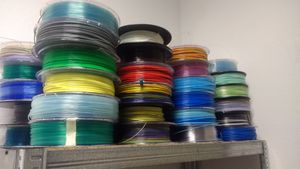Material:PLA: Difference between revisions
Created page with "{{MaterialInfoBox |material name=PLA |image= |synonyms=polylactic acid, polylactide;<br>DE: "Polymilchsäure" |available=yes (as filament) |donation=5 ct/g |location=3D..." |
→Joining: contact glue |
||
| (2 intermediate revisions by 2 users not shown) | |||
| Line 1: | Line 1: | ||
{{MaterialInfoBox | {{MaterialInfoBox | ||
|material name=PLA | |material name=PLA | ||
|image= | |image=PLA.jpg | ||
|synonyms=polylactic acid, polylactide;<br>DE: "Polymilchsäure" | |synonyms=polylactic acid, polylactide;<br>DE: "Polymilchsäure" | ||
|available=yes (as [[filament]]) | |available=yes (as [[filament]]) | ||
| Line 33: | Line 33: | ||
== Joining == | == Joining == | ||
* [[ | * [[Contact Glue|contact glue]] works well | ||
* [[Hot Glue|hot glue]] works rather well but can leave unsightly blobs | * [[Hot Glue|hot glue]] works rather well but can leave unsightly blobs | ||
* [[Construction Glue|construction glue]] has worked in a project combining PLA and [[wood]] | * [[Construction Glue|construction glue]] has worked in a project combining PLA and [[wood]] | ||
* [[Plastic Welding|plastic welding]] may be an option! | * [[Plastic Welding|plastic welding]] may be an option! | ||
* [[Super Glue|super glue]] does '''not''' work well at all | |||
== Experiments == | == Experiments == | ||
There are a few things that could be interesting to do, e.g. finding out how well shredded PLA is actually composted or which techniques could be used to smoothen the surface of a print. More on that later... | There are a few things that could be interesting to do, e.g. finding out how well shredded PLA is actually composted or which techniques could be used to smoothen the surface of a print. More on that later... | ||
== Further Reading == | |||
* [http://reprap.org/wiki/PLA RepRap wiki] | |||
[[Category:3D Printing]] | |||
[[Category:Elementary Materials]] | [[Category:Elementary Materials]] | ||
[[Category:Plastics]] | [[Category:Plastics]] | ||
Latest revision as of 13:56, 10 February 2025
| MaterialInfoBox PLA | |
|---|---|

| |
| Synonyms: | polylactic acid, polylactide; DE: "Polymilchsäure" |
| On Site? | yes (as filament) |
| Location: | 3D printer farm |
| Suggested Tools: | 3D printers, hot air gun, hot air soldering station, knives, rotary tool, files, twist drill bits, sandpaper |
PLA is a thermoplastic with excellent properties when it comes to 3D printing. Pure PLA is a biodegradable bioplastic, but our 3D printing filaments contain softeners and pigments that might be less healthy or cause the material to degrade slower than the pure compound.
Material Science
- trivial name: polylactic acid
- origin: usually corn starch or whey
- melting point: 150-160 °C
- biodegradation: debated, estimates from years to hundreds of years
- recycling ideas: extrude into new printing filament
- solvents: chlorinated solvents and other nasty chemicals we don't want on site - sorry to disappoint you...
- RIC: #7 - OTHER
(mostly from Wikipedia)
Health & Safety
If you have been close to a 3D printer for a while you probably noticed a bit of that burnt plastic smell most people find rather unpleasant. As mentioned before, PLA is not inherently bad but there might be some nasty additives in some (cheap) filaments. We try to use the good ones and have found a great partner for locally produced filament, but it is a good idea to keep the area well ventilated anyway. We are planning to build fume hoods around our printers as well.
There is some scientific data regarding fumes.
Finishing
(also see 3D print postprocessing)
Painting
- acrylic paint tends to peel off after a while
Joining
- contact glue works well
- hot glue works rather well but can leave unsightly blobs
- construction glue has worked in a project combining PLA and wood
- plastic welding may be an option!
- super glue does not work well at all
Experiments
There are a few things that could be interesting to do, e.g. finding out how well shredded PLA is actually composted or which techniques could be used to smoothen the surface of a print. More on that later...